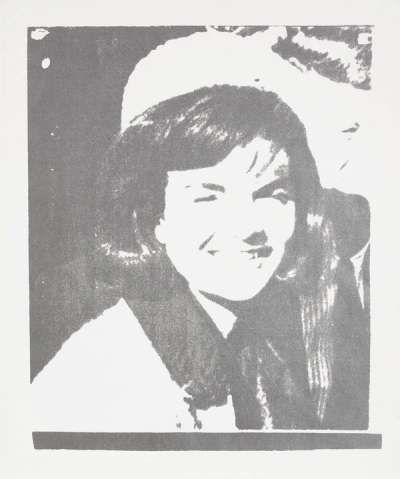Jackie
Kennedy
Begun in 1963 shortly after President Kennedy's assassination, Andy Warhol spotlights the widowed Jackie, demonstrating his interest in the media aftermath of high-profile, tragic deaths. Unlike similar print series, this portfolio is made unique by its monochromatic palette, which heightens its mournful atmosphere and fidelity to the newspaper images Warhol appropriates.
Andy Warhol Jackie Kennedy For sale
Jackie Kennedy Value (5 Years)
With £53538 in the past 12 months, Andy Warhol's Jackie Kennedy series is one of the most actively traded in the market. Prices have varied significantly – from £1545 to £41669 – driven by fluctuations in factors like condition, provenance, and market timing. Over the past 12 months, the average selling price was £10707, with an average annual growth rate of 7.55% across the series.
Jackie Kennedy Market value
Auction Results
| Artwork | Auction Date | Auction House | Return to Seller | Hammer Price | Buyer Paid |
|---|---|---|---|---|---|
 Jacqueline Kennedy III (F. & S. II.15) Andy Warhol Signed Print | 25 Nov 2025 | Bonhams New York | £9,775 | £11,500 | £14,500 |
 Jacqueline Kennedy I (F. & S. II.13) Andy Warhol Signed Print | 17 Oct 2025 | DuMouchelles | £6,375 | £7,500 | £9,000 |
 Jacqueline Kennedy II (F. & S. II.14) Andy Warhol Signed Print | 19 Mar 2025 | Tate Ward Auctions | £8,925 | £10,500 | £14,000 |
Sell Your Art
with Us
with Us
Join Our Network of Collectors. Buy, Sell and Track Demand
Meaning & Analysis
While obviously demonstrative of Warhol’s fascination with celebrity, a preoccupation with death also underlies his Jackie Kennedy portraits. Then, in 1963, the United States was brought to a standstill by the assassination of President John F Kennedy. According to reports Warhol seemed unmoved by the event, however, his interest was later piqued by the images of the grief stricken Jackie Kennedy plastered across newspapers and bulletins at the time.
That same year Warhol decided to make a portfolio of Jackie prints, choosing two photographs of her wearing her pink Chanel suit before the assassination, two from the swearing in of Lyndon B Johnson and four from her husband’s funeral. In this way, Warhol’s portfolio presents a portrait of grief haunted by the spectre of past happiness. The colours tend to be muted, with greys and blues placed on top of the deep black of the photocopied image of the former first lady, her beautiful features and glamorous style frozen in time. Though she wasn’t a film star, Jackie had captured the hearts of women all over America. Warhol’s decision to focus on her face rather than that of her husband’s shows his canny instinct for picking out an icon.
As well as commenting on the repetition of images during the media frenzy around Kennedy’s death, the works also reveal Warhol’s own preoccupation with death. This theme creeps into his oeuvre in the form of skulls, guns and electric chairs. Critics have also speculated that Warhol’s Orthodox Catholic upbringing may have influenced his fascination with famous and beautiful women, elevating them to the status of saints in a modern take on the religious icon as he imbued them with colour and sometimes even gold leaf and diamond dust. In a world where newsreaders and talk show hosts commanded more power than the heads of the Catholic Church Warhol may have seen the need for a new iconography for a secular society obsessed with celebrities.














